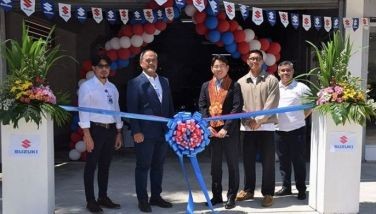Bowtie racing 101
One of the biggest ironies in the local automotive industry is that one of the oldest and most well-known brands in the world’s biggest car market, North America, is perhaps among the least well-known in the Philippine market.
I’m talking about Chevrolet, the carmaker with the iconic Bowtie logo. Sure we know that it’s part of General Motors. Some of you may even know that the company celebrated its 100th anniversary last week
But for a 100-year-old company, precious few details are known about the company – at least in this local market.
Many Filipinos know about Ferdinand Porsche or Enzo Ferrari or Henry Ford. Or even about Soichiro Honda or Kiichiro Toyoda. But have you heard of Louis Chevrolet? This Swiss born US immigrant was working as a chauffeur in New York when, driving an old underpowered Fiat, he defeated the then unbeaten Barney Oldfield in a head-to-head race in 1905. His victory made the front page in the New York Times.
Four years later, General Motors founder William C. “Billy” Durant commissioned Chevrolet to drive and help develop his Buick racing cars. After Durant lost control of GM in 1910, he and Chevrolet began a new car venture, which became the Chevrolet Motor Car Company on Nov. 3, 1911. Within a decade, Chevrolet had become part of the growing GM empire.
And while the racing and rallying exploits of familiar brands like Ford, Honda, Mercedes-Benz, BMW, Mitsubishi, and Subaru are well-documented – or at least common knowledge among the local cognoscenti – even local car buffs seem to run short when it comes to Bowtie racing lore.
Which is a shame, because a legacy of motorsports triumphs runs deep within Chevrolet. For one thing, Chevy has won America’s single most watched racing series, NASCAR, a stunning 35 times, making it the most successful name in that series’ history. Chevrolet’s V8 racing engines have also won the highly competitive Indy 500 seven times between 1988 and 2002.
On the global stage, the Chevrolet Corvette has taken no less than seven class trophies at the grueling 24 Hours of Le Mans. The racing version of the Chevrolet Cruze, which since its 2009 debut has become the company’s bestselling car globally, also claimed the World Touring Car Championship (WTCC) in 2010 and 2011. It’s the first ever General Motors vehicle to win such honors in an FIA-organized series.
Then there’s the little known fact about Chevrolet and the late, great Juan Manuel Fangio. The 5-time Formula One world champion may have won his titles behind the wheel of various Mercedes, Alfa Romeos, Ferraris and Maseratis; but in 1940 the Argentine won the Grande Premio Internacional del Norte, a grueling two-week, 6,000-mile race from Buenos Aires over the Andes mountains to Lima, Peru, and back – behind the wheel of a Chevrolet. In fact, he was a double national champion in Argentina driving a Chevy.
The Indy 500? No car company has been more closely associated with the legendary 500-mile race over the last 100 years than Chevrolet. Both institutions got their start in 1911. And by 1920, Chevrolet had won the Indy 500. It repeated the feat the following year.
In the 1980s, Chevrolet V8 racing engines won six consecutive 500s. From its debut in 1986 until 1992, it won 64 of 78 Champ Car series races, including six consecutive Indy 500s. The roster of drivers racing Chevy-powered entries included such Indy car superstars as Rick Mears, the Unser family, Danny Sullivan, Emerson Fittipaldi, and Mario Andretti. And now, a brand-new 2.2-liter twin-turbo V6 Indy engine is being prepared for 2012.
The efforts that went into entering the 1956 Sebring 12-hour endurance race had a monumental effect on Chevrolet as high-performance automotive brand. Pre-race testing of the corvette race cars produced numerous parts failures. Attempts to deal with them on the fly evolved into a new quick-response system within Chevrolet’s engineering department. And, since Sebring rules forbade the use of non-production parts, the more robust components had to be immediately available through Chevrolet dealers, a situation that led to the creation of a new factory “heavy-duty” parts distribution system. Soon, Chevrolet was America’s premier source for race-inspired knowledge and hardware.
In the late 50s, American road racing cars were still a curiosity in Europe. No surprise that the four Corvettes appearing on the grid for the 1960 edition of the Le Mans 24-hour race were given considerable attention, but not much respect. But when Corvette driver John Fitch turned quicker lap times than the Ferraris, Porsches and Aston Martins, a few in the crowd took notice.
Twenty-four hours after the green flag dropped, co-driver Bob Grossman drove the Corvette across the finish line for a class win. Five decades later, to the delight of European racing fans, that Corvette was back at Le Mans, with 93-year-old John Fitch at the wheel for a lap of honor.
The Chevy small-block V8 was a racer’s dream, even in non-Chevrolet cars. Light in weight and compact in size, it readily fit into diminutive engine bays. It was also powerful, inexpensive, durable, easy to maintain and easily available. Chevrolet dealers stocked heavy-duty parts, and aftermarket manufacturers offered additional performance equipment, elevating the Chevy small-block into the pantheons of the greatest engines of all time.
Going back to NASCAR, some of the most recognized names in the series are found among the teams and drivers who have taken the Bowtie brand to its unsurpassed 35 NASCAR championships.
Junior Johnson, Richard Childress and Rick Hendrick rank with the elite of today’s NASCAR team owners while 7-time champion Dale Earnhardt booked back-to-back crowns in 1986 and 1987 that cemented Chevrolet’s winning tradition. More recently, drivers such as Tony Stewart, Dale Earnhardt, Jr., Jeff Gordon, and Jimmie Johnson, winners of nine NASCAR championships between them, have carried the Bowtie torch.
A turning point in Chevrolet’s approach to motorsports occurred in the late 1990s, when the Corvette factory racing team was established. Since 1999, Corvette Racing has garnered seven class wins at Le Mans, and eight American Le Mans Series championships. The group also took an overall win at the Rolex 24 at Daytona in 2001.
And in a rare nod to the elegance of pushrod overhead valve (non-overhead cam) engine design, the Corvette LS7.R engine that won – with a perfect reliability record – the 2006 American Le Mans Series, was named the Global Motorsport Engine of the Year by 50 race engineers polled by England’s Race Car Engineering magazine.
But of all the great Corvette runs at Le Mans since 1960, none were more exciting and dramatic than the 2011 GTE Pro class victory – accomplished during Chevrolet’s Centennial year – when with just two hours to go of the 24-hour race, a Corvette slipped past the leading Ferrari to take the win.
Closer to home is the World Touring Car Championship (WTCC), which is known for its motto, “Real Cars, Real Racing.” It is one of only three world championships sanctioned by the FIA alongside Formula One and World Rally Championship (WRC).
The WTCC is proving to be a splendid venue for showcasing the racing version of the bestselling Chevrolet Cruze, which made its WTCC debut in 2009. The turbocharged 1.6-liter Cruze has secured the 2011 WTCC manufacturer and driver’s championships for Chevrolet, repeating its 2010 feat.
When he drove his Cruze to victory in both races at Valencia, Spain last September – thereby clinching the title – reigning world champion Yvan Muller became the most successful driver in WTCC history. To date and with two races to go, the Cruze race cars combined to garner a total of 17 race wins (out of a possible 20), a perfect record of 20 pole positions, 15 fastest laps, and a whopping 35 podium finishes this year.
No surprise then that the production Cruze drives like a winner. I’ve always applauded its taut chassis and responsive handling. Even the diminutive Spark rides and drives well – to say nothing of the Camaro; you’ve just got to drive it to believe it. After one century, Louis Chevrolet’s competitive spirit still lives on in the cars that bear his name.
- Latest
































